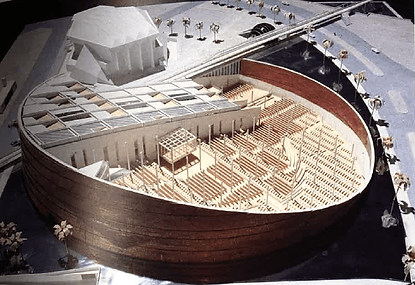
Bibliotheca Alexandrina
2002, Egypt

Thinking Through Alfred Gell (1945-1997)’s “Art and Agency” and “The Technology of Enchantment”
An Index of Civilization’s Ghost
In Alfred Gell’s framework, art is not about meaning, but about agency—objects acting upon people, ensnaring them in networks of intentionality. The Bibliotheca Alexandrina, built near the site of the ancient Library of Alexandria, is a resurrected agent—a proxy through which the memory of a long-dead yet ever-haunting cultural ambition acts upon the present.
The elliptical, sloped disk of the library’s roof tilts toward the Mediterranean sun like an eye awakening. Its massive granite wall, carved with scripts of every known language, functions as an indexical surface—the Gellian “index” made literal. The wall is a semiotic altar: language becomes ornament, and the ornament becomes an invocation to lost knowledge.
Distributed Intentionality: From Myth to Modernity
The building is more than a center of learning. It is a ritualistic act of recovery, a gesture of defiance against the historical trauma of civilizational amnesia. In Gell’s theory, objects embody “distributed personhood”—and here, the building is a collaboration of nations, disciplines, histories, and spectral intentions. It is not merely a house of books; it is a re-networking of global memory.
Every stairwell, every glass floor pane, every shaft of indirect light becomes an intentional act—seducing the visitor not to consume knowledge, but to worship it. The user of this space is not a passive observer; they are an initiate in a modern cult of remembrance.
The Technology of Enchantment as Reconstitution
For Gell, the technology of enchantment is the act of imposing complexity—forcing the viewer to marvel at what seems impossible to realize. Bibliotheca Alexandrina’s structure, with its vast tilted circular roof, mirrored pools, and sun-calibrated reading rooms, creates a perceptual apparatus in which space behaves like a ritual script.
The enchantment lies not in spectacle, but in symbolic restoration. The building does not claim to be the ancient library. Rather, it functions as its enchanted doppelgänger—a proxy empowered to restore what was lost by enchanting the idea of intellectual continuity.